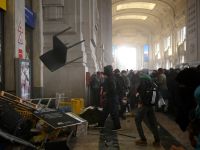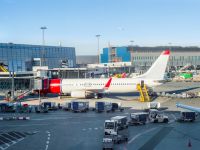Common power plant structure. Power plants that generate electricity from nuclear energy are similar in structure to plants that use fossil fuels—coal, oil, natural gas—as an energy source. At all power plants, except hydroelectric plants, high-pressure steam "blows" the propeller-like blades of a turbine, which spins the shaft of a huge generator. Inside the generator, a coil of wire spins in a magnetic field to create electricity.
Different processes to produce heat. The heat needed to boil water into steam in a power plant is produced either by burning coal, oil, or natural gas in a furnace, a chemical process, or by splitting atoms of uranium in a nuclear reactor, a physical process.
Nuclear fission does not involve burning or explosions. Nothing is burned or exploded in a nuclear power plant. Rather, the uranium fuel—tons of it—generates heat through a process called fission. These plants do not produce electricity through nuclear explosions and the electricity is not radioactive. In fact, the nuclear fuel in a commercial nuclear power plant cannot explode.
The fission process inside a nuclear plant. The uranium used as fuel in a nuclear plant is formed into ceramic pellets about the size of the end of your little finger. These pellets are inserted into long, vertical tubes within the reactor core. As uranium atoms in these pellets are struck by atomic particles, they split—or fission—to release particles of their own. These particles—called neutrons—strike other uranium atoms, splitting them. This sequence of one fission triggering others, and those triggering still more, is called a chain reaction. When the atoms split, they also release heat. This heat is known as nuclear energy.
Controlling the fission process in a nuclear plant. The nuclear reaction inside the reactor is controlled by rods inserted among the tubes holding the uranium fuel. These control rods are made of a material that absorbs neutrons and prevents them from hitting atoms that can fission. In this way, the nuclear reaction can be speeded up or slowed down by varying the number of control rods withdrawn and how much they are withdrawn.
Types of Nuclear Power Plants:
Two types of U.S. nuclear plants operate on the same principles. Commercial nuclear power plants in the United States are either boiling water reactors or pressurized water reactors. Both are cooled by ordinary water. The coolant—the water—is the main link in the process that converts fission energy to electrical energy.
Boiling water reactors. In boiling water reactors, the water is heated by the nuclear fuel and boils to steam directly in the reactor vessel. It is then piped directly to the turbine. The turbine spins, driving the electric generator, producing electricity. Boiling water reactors are manufactured by General Electric.
Pressurized water reactors. In pressurized water reactors, the water is heated by the nuclear fuel but kept under pressure to prevent it from boiling. Instead, the hot water is pumped from the reactor pressure vessel to a steam generator. There the heat of the water is transferred to a second, separate supply of water, which boils to make steam. The steam spins the turbine, driving the electric generator, producing electricity. Pressurized water reactors are manufactured by Babcock and Wilcox Company; Westinghouse Electric Corporation; and the former Combustion Engineering, Inc., now a part of Westinghouse.
The Uranium Fuel Used in a Nuclear Plant:
Same fuel used in boiling water and pressurized water reactors . Both U.S. nuclear reactor types use essentially the same fuel—a solid material containing two kinds, or isotopes, of uranium atoms. One isotope—U-235—makes up less than one percent of natural uranium but fissions readily. The other isotope—U-238—makes up most of natural uranium but is practically non-fissionable.
Enrichment increases the fuel’s power but far too little to explode. Through a process know as "enrichment," the concentration of U-235 in the uranium is increased to three to five percent. Among other benefits, enrichment enables the reactor to be smaller than it would have to be if fueled with natural uranium. The concentration of U-235 is so low in enriched power-plant uranium that a nuclear explosion is impossible.
Nuclear fuel changes as it is used. Certain changes take place in the ceramic fuel pellets during their time in the reactor of the nuclear power plant. In addition to causing the fissioning of the U-235 fuel, some neutrons strike the U-238 atoms and turn them into plutonium, another fissionable element. Some of the plutonium itself undergoes fission, adding to the production of heat in the reactor.
Replacing fuel in a nuclear reactor. Most of the fragments of fission—the particles left over after the atom has split—are radioactive. During the life of the fuel, these radioactive fragments collect within the fuel pellets. The fuel remains in the reactor for three to four years before most of the U-235 is fissioned and trapped fission fragments begin to reduce the efficiency of the chain reaction. Between one-fourth and one-third of the fuel rods are replaced every 12-18 months.
Storing used nuclear fuel. The fuel removed from a U.S. power plant reactor—sometimes referred to as "nuclear waste" or "high-level waste"—is stored under water at the nuclear plant site in large concrete vaults lined with stainless steel and in above-ground dry storage facilities in steel and lead containers placed inside concrete vaults. Eventually, this used fuel will be transported to a centralized storage facility under the national used nuclear fuel management program run by the U.S. Department of Energy.
Natural Safety Features in a Nuclear Plant:
Ceramic pellets resist temperature and corrosion. The uranium fuel is formed into ceramic pellets, which resist the effects of high temperature and corrosion during operation.
Fuel pellets are only partially fissionable. The concentration of fissionable U-235 in fuel pellets is very low. Because the U-235 is diluted with other, non-fissionable U-238, materials, the chain reaction tends to slow down as it gets hotter.
The metal of fuel pellet tubes resists radiation. Fuel pellets are stacked end-to-end in 12-foot long tubes made of a special metal—zirconium alloy—which resists heat, radiation, and corrosion.
Control rods manage the reaction. The fuel pellet tubes are precisely arranged as assemblies within the reactor, with spaces between them for the control rods. Control rods—made of a material that absorbs neutrons and prevents fission—can speed up or slow down the nuclear reaction. In a boiling water reactor, the control rods go between the fuel assemblies.
In a pressurized water reactor, the control rods are mixed in the assemblies with the fuel rods.
Water removes heat and can slow the reaction. Water flowing up through the assemblies removes the heat of the chain reaction. Water also serves as a "moderator." It slows down the neutrons and increases the probability of fission. Rather than hitting the nucleus, the neutron must combine with it momentarily.
If the neutrons are moving too quickly, fission is unlikely to occur. This "moderating" effect of the water adds another safety feature. Any loss of water—from overheating and boiling into steam or from a leak—slows the chain reaction. In a boiling water reactor, as the water boils, voids in the water are created, reducing the moderating effect. As the water gets hotter, more moderation is lost and the reaction automatically begins to slow down.
Multiple redundant safety systems. Nuclear plants are designed according to a "defense in depth" philosophy that requires redundant, diverse, reliable safety systems. Two or more safety systems perform key functions independently, such that, if one fails, there is always another to back it up, providing continuous protection.
Highly reliable automated safety systems. A nuclear plant has many built-in sensors to watch temperature, pressure, water level, and other indicators important to safety. The sensors are connected to control and protection systems that adjust or shut down the plant, immediately and automatically, when pre-set safety limits are approached or crossed.
Physical barriers safely contain radiation and provide emergency protection. The fuel rod assemblies are contained within a large, thick steel reactor vessel. In turn, the reactor vessel and extensive safety and steam generation equipment are enclosed in a massive, reinforced steel and concrete structure, the "containment," whose walls are three to four feet thick.
Source:WWW..NEI.ORG.







